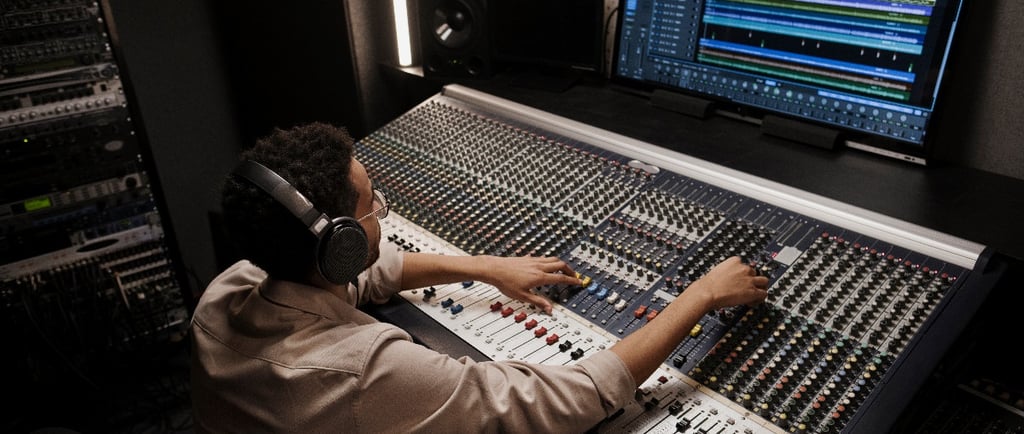Soundproofing and Acoustics for Recording Studios
DIGI Acoustics


Table of Contents
Introduction
What Is Soundproofing?
What Are Acoustics in a Recording Studio?
Key Differences Between Soundproofing and Acoustics
Why Soundproofing Is Essential in a Studio
The Science of Acoustics: Why It Matters
Step-by-Step Guide to Soundproofing Your Studio
Acoustic Treatment Techniques That Work
Materials Used in Studio Soundproofing and Acoustic Treatment
Common Mistakes to Avoid
DIY vs. Professional Studio Setup
Cost Considerations
Future-Proofing Your Studio
Final Tips for a Perfect Studio
Conclusion
1. Introduction
Clear sound is everything in a recording studio. No amount of post-production can fully fix poor-quality audio caused by outside noise or bad room acoustics. If you want professional-grade results, you need both soundproofing and acoustic treatment. These two work together — like silence and music — to create a perfect recording environment.
2. What Is Soundproofing?
Soundproofing is the process of blocking sound from entering or leaving a room. The goal is to create a quiet space where external noises don’t bleed into your recordings — and your studio work doesn't disturb others.
There are four basic principles of soundproofing:
Mass: Using heavy, dense materials to block sound
Damping: Reducing vibrations that carry sound
Decoupling: Creating air gaps to prevent sound transfer
Absorption: Using soft materials to soak up sound energy
3. What Are Acoustics in a Recording Studio?
Acoustics refer to how sound behaves inside a space. It's all about controlling reflections, reverb, flutter echoes, and standing waves. The aim is not to make the room silent — but to make it sound natural and accurate.
Good studio acoustics mean:
Accurate sound reproduction
Better mixing and mastering
Clearer recordings
4. Key Differences Between Soundproofing and Acoustics
Here’s a quick comparison to help you understand the distinction:
AspectSoundproofingAcousticsPurposeBlock external/internal soundControl internal sound reflectionsMaterialsMass-loaded vinyl, drywall, insulationAcoustic panels, bass traps, diffusersEffectKeeps sound in/outImproves sound quality insideResultQuieter spaceBalanced, natural sound
Both are essential for a high-performance studio.
5. Why Soundproofing Is Essential in a Studio
You might think your neighborhood is quiet enough — until you hit record and hear:
Traffic rumble
Dogs barking
Ceiling fans
Footsteps from the floor above
Even minor noise leaks can ruin a good take. Soundproofing ensures:
Consistent recording conditions
Privacy for clients and artists
Freedom to record at any hour
It also prevents sound leakage, so your loud music or drum sessions don’t upset neighbors.
6. The Science of Acoustics: Why It Matters
A room with poor acoustics can:
Muffle your vocals
Exaggerate bass
Add weird echo or reverb
Mask important sound details
That’s why acoustic treatment focuses on:
Absorption (to reduce reflections and flutter echo)
Diffusion (to scatter sound for a more even tone)
Bass trapping (to control low frequencies)
Balanced acoustics help you hear your recordings exactly as they are — not colored by the room.
7. Step-by-Step Guide to Soundproofing Your Studio
Ready to start soundproofing? Here’s a basic roadmap:
Step 1: Inspect and Seal the Room
Use acoustic caulk to seal all gaps and cracks
Install weather stripping on doors
Ensure windows are double-glazed or use soundproof curtains
Step 2: Add Mass
Add extra drywall layers with Green Glue between them
Use mass-loaded vinyl (MLV) behind walls or under floors
Step 3: Decouple the Structure
Build a room-within-a-room if possible
Use resilient channels or sound isolation clips to disconnect drywall from framing
Step 4: Install Soundproof Doors and Windows
Standard doors leak sound — replace with solid-core doors
Use soundproof window inserts or acoustic-grade glass
8. Acoustic Treatment Techniques That Work
Install Acoustic Panels
These absorb mid and high-frequency sounds, improving vocal clarity.
Place Bass Traps in Corners
Low frequencies tend to build up in corners. Bass traps reduce the “boominess” of a room.
Add Ceiling Clouds
These panels hang from the ceiling and absorb sound from above — especially useful in rooms with high ceilings.
Use Diffusers Strategically
Diffusers break up reflections and spread sound evenly. They're great for live recording rooms and control rooms.
Treat First Reflection Points
Use a mirror on the wall — wherever you can see the speakers from your seat, sound reflects. Treat those spots with panels.
9. Materials Used in Studio Soundproofing and Acoustic Treatment
Here are some of the best materials you’ll need:
Soundproofing Materials
Mass-Loaded Vinyl (MLV)
Green Glue Damping Compound
Acoustic Sealant
Soundproof Drywall (like QuietRock)
Resilient Channels
Acoustic Treatment Materials
Fabric-wrapped fiberglass panels
Rockwool insulation
Open-cell acoustic foam
Wooden diffusers
Bass traps made from dense fiberglass
Pro Tip: Don’t confuse cheap foam panels for professional acoustic treatment. Foam helps only with highs — not with mids or bass.
10. Common Mistakes to Avoid
Thinking foam solves everything – It doesn’t.
Not treating corners – Bass builds up here the most.
Over-treating the room – Too much absorption can make it sound dead.
Ignoring ceiling reflections – They play a huge role in room acoustics.
Skipping decoupling – This step is vital for real soundproofing.
11. DIY vs. Professional Studio Setup
DIY soundproofing can save money, but it requires:
Technical knowledge of building materials
Experience with construction tools
Careful attention to detail
Professional installation, though more costly, ensures:
Optimal sound isolation
Correct placement of treatment
Aesthetically finished space
If you’re building a studio for commercial use, professional help is often worth the investment.
12. Cost Considerations
Here’s a general breakdown:
ComponentDIY Cost (INR)Pro Installation (INR)Soundproofing₹60 – ₹200/sqft₹150 – ₹400/sqftAcoustic Panels₹300 – ₹1000 per panel₹500 – ₹1500 per panelBass Traps₹500 – ₹2000 each₹1000 – ₹2500 eachComplete Room Setup₹50,000 – ₹2,00,000₹1,00,000 – ₹5,00,000+
Prices vary based on room size, materials used, and labor.
13. Future-Proofing Your Studio
Use modular panels that you can move or upgrade
Plan for expansion if you might grow your setup
Install ample cable management and power sockets
Test your room regularly to adapt to any sound changes
14. Final Tips for a Perfect Studio
Always test your room acoustics before final installation
Use a Room EQ Wizard (REW) software for frequency analysis
Maintain a balance between absorption, diffusion, and reflection
Don’t copy others blindly — design your studio to suit your recording needs
15. Conclusion
Creating a recording studio with excellent soundproofing and acoustics isn’t just about spending money — it’s about making smart, informed choices. A well-treated space helps you deliver professional-quality audio, every time. By combining sound isolation techniques with the right acoustic treatment, you can create a room that both sounds amazing and feels comfortable to work in.
Whether you’re setting up a home studio or a commercial recording suite, take the time to get it right. The results will speak — and sound — for themselves.
FAQs – Recording Studio Soundproofing & Acoustics
1. What is the difference between soundproofing and acoustic treatment in a recording studio?
Soundproofing prevents external noise from entering or internal noise from escaping the room. Acoustic treatment, on the other hand, controls how sound behaves inside the studio to ensure clarity and accuracy during recording and mixing.
2. Why is soundproofing important for a recording studio?
Soundproofing creates a quiet and controlled environment, blocking out unwanted external noises like traffic, voices, or machinery. It also prevents sound from leaking out and disturbing others.
3. How do I treat the acoustics in a recording studio?
You can improve room acoustics by adding acoustic panels, bass traps, ceiling clouds, and diffusers. These help control sound reflections, echo, and frequency imbalances.
4. Can I build a recording studio in a small room at home?
Yes! Even small rooms can be transformed into high-quality home studios with proper soundproofing and acoustics. DIGI Acoustics specializes in custom studio design for any room size.
5. What materials are used for studio soundproofing?
Common soundproofing materials include:
Mass-Loaded Vinyl (MLV)
Acoustic sealant
Double-layer drywall
Green Glue
Resilient channels
Solid-core doors
6. What are the best materials for acoustic treatment?
Acoustic treatment materials include:
Rockwool or fiberglass panels
Foam diffusers
Wooden diffusers
Fabric-wrapped panels
Bass traps for corners
7. How long does it take to build a professional recording studio?
Depending on the size and complexity, it can take 1 to 4 weeks. DIGI Acoustics offers both standard and custom-built studio setups, delivering timely and professional results.
8. Do I need both soundproofing and acoustic treatment?
Yes. Soundproofing isolates the room from noise, while acoustic treatment makes the recorded sound accurate and natural. Both are essential for a high-performance studio.
9. Can DIGI Acoustics design and build a recording studio for me?
Absolutely! DIGI Acoustics specializes in end-to-end recording studio setups, including:
Room analysis and design
Soundproofing construction
Acoustic treatment installation
Studio aesthetics and lighting
Equipment integration
we provide expert acoustics and soundproofing solutions
Important Links
+91 9100720404
© 2025 DIGI Acoustics. All rights reserved.
2-22-1/173/1, Bhagya Nagar Colony, Kukatpally, Hyderabad, Telangana 500072
Address


